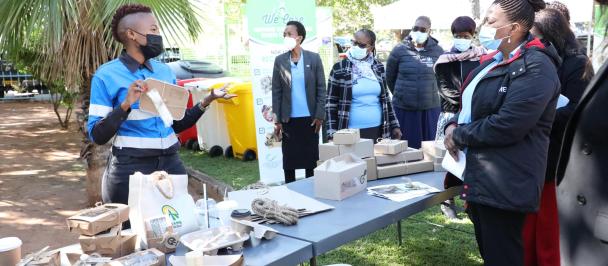Capacity Building for Communities in Kgalagadi on Bushfire Fighting Commences
July 9, 2022
Middlepits, Kolonkwaneng, and Bogogobo villages cluster bushfire fighting training from 1st to 4th August 2022
The Kgalagadi District is located in the southwestern part of Botswana and forms part of the Western Region (which includes the Ghanzi District and North West District). Kgalagadi shares its borders with Ghanzi to the north and Kweneng and Southern districts to the east. To the west is the border with Namibia, whereas the south and south-western borders are shared with the Republic of South Africa. The District covers an area of approximately 110,110 km2, equivalent to 10% of Botswana’s total area.
Vegetation zones in the area include arid shrub savanna, Kalahari bush savanna, and tree savanna and include some important veld products such as the Devils Claw (Harpagophytum procumbens) and Kalahari truffles (Terfezia pfeilii). Livestock grazes not only on grasses but also browse. Small stock (sheep and goats) also browses shrubs.
Kgalagadi District has been overwhelmed by repeated incidents of bushfire year in and year out, which caused serious damages to property, biodiversity, and at times staid casualties. The normal bush fire season for the district is July to November every year with the peak period being from August to October.
Sione Gaeemelwe, a 34-year-old lady farmer and resident of Kolonkwakeng village in Kgalagadi district narrates how she fell victim to a veld fire outbreak in 2021. She says in October 2021 there was a fire outbreak in the district and the fire spread to her cattle post where it ravaged thirty-four of her small stock which at the time was in their kraal. She says she struggled to put out the fire and only managed to save just a few. She reiterated that the veld fire consumed the entire grazing land in her area leaving them with nothing to feed their animals on.
The UNDP-supported project “Managing the Human-Wildlife Interface to sustain the flow of Agro-Ecosystem Services and prevent Illegal Wildlife Trafficking in the Kgalagadi and Ghanzi Drylands” commonly known as Kgalagadi and Ghanzi Dryland Ecosystem Project (KGDEP), GEF-6 Child Project under the Global Wildlife Programme, recently conducted community bushfire fighting training in Kgalagadi South, Botswana. The KGDEP, in collaboration with the Department of Forestry and Range Resources (DFRR), conducted one of four cluster community bushfire fire first responder training in Middlepits, Kgalagadi South. The training is part of the project's larger goal, which focuses on integrating Sustainable Land Management (SLM) practices in communal areas.
In his welcome remarks, Kgosi Moseki of Middlepits village stated that he is pleased that training had begun in his village. He stated that there was a veld fire outbreak in the year 2021 and community members volunteered to respond and put it out but found it practically difficult to do the task. He said their response was slow and the fire eventually spread widely to other places. Moseki attributed the inability to put off veld fire to lack of knowledge and technical skills in bushfire fighting in his community.
Middlepits, Kolonkwaneng, and Bogogobo villages cluster bushfire fighting training
It is recorded that the district registered 42 fire outbreaks in the previous year, 23 of which occurred in Kgalagadi north and 19 in Kgalagadi south, resulting in negative effects on pastoral farming and the tourism sector due to persistent fire. Furthermore, fire infiltrated the Kgalagadi Transfrontier Park, causing campsite damage and posing hazards to wildlife. It was discovered during the fires that community members could not respond to fires, emphasizing the importance of this training in the district. The KGDEP also used the opportunity to provide a brief overview of the project to the communities about the overall project components, outputs, and community livelihood development initiatives.
The training targeted first responders in bush firefighting at a community level, which is mainly the Botswana Police Services, Village Development Committees (VDCs), and the general members of the community.
“It is common practice and requirement by law, that in instances of fire outbreaks community members are gathered to quickly attend to fire outbreaks as first responders, however, the challenge has been that most participants will normally have minimal or no firefighting training therefore their effectiveness as first responders have been very minimal”
The engagement of these untrained and under-capacitated community members also exposes them to different hazards and dangers that come along with firefighting. Therefore, this training aims to provide the communities with basic bushfire fighting and safety skills to increase their effectiveness as first responders.
The series of training commenced with the Middlepits, Kolonkwaneng, and Bogogobo villages cluster where among the 32 participants, 14 were males and 18 were females.
The DFRR donated fifteen (15) aluminum fire beaters to the three villages at the end of the training to be used in community fire response. More fight fighting equipment will be procured and delivered to the communities to increase the capacity and effectiveness of fight fighting.

 Locations
Locations